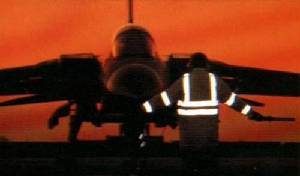|
| The Flight Deck Is No Place A Dark Navy P-Jacket |

|
| Launchperson Is Illuminated With 3M's SOLAS Scotchlite |
RETRO-REFLECTIVITY
What does it mean ?
Retroreflectivity is the proper term given to materials having
the ability to return (retro) most of the light back to it’s originating light source. MANY ITEMS ARE REFLECTIVE; metal
foil, a white T-shirt, even a darker colors. BUT, the light reflecting off them (the light that's not absorbed by the
color itself) is scattered in many directions, because they DO NOT POSSESS the ability to refocus the light hitting them back
to the light source.
SO, WHILE THEY MAY BE REFLECTIVE THEY ARE NOT RETROREFLECTIVE.
The performance level of retroreflective materials is measured
in candle power. Official data offers that white clothing has only a performance level of up to 0.3 candle power, a vehicle
license plate has 50, and a conforming retro-reflective material has 500 candle power. There is of course a direct relationship
between reflective index (candle power) and the distance from which it can be seen.
There are two main types of retro-reflective material: one
achieves its retro-reflectivity by using a cube corner prism, the other the glass bead principal. In the former, light
is reflected off the multiple faces of the prism, in the other it is reflected off the rear face of the bead.
|

